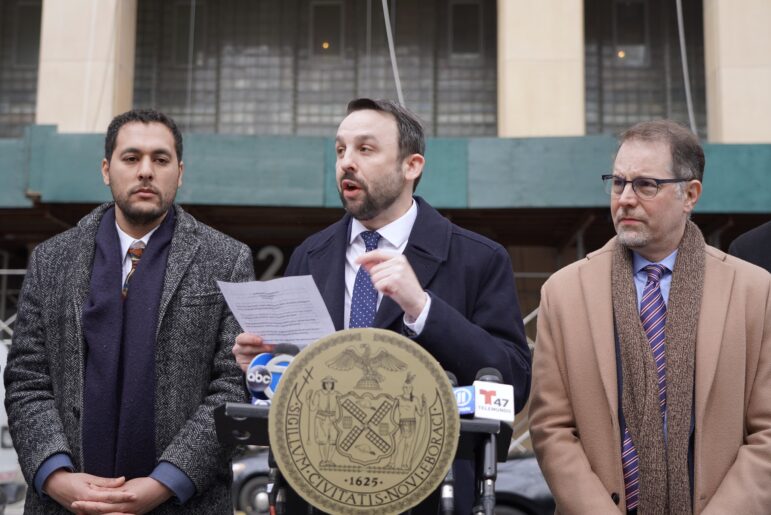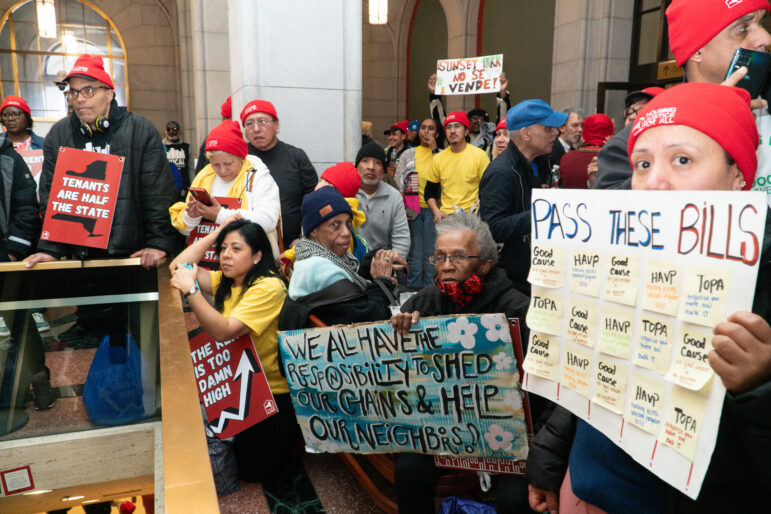When the city’s Department of Environmental Protection proposed a 14.5 percent increase in water rates on Friday, it was bad news for every New Yorker who pays a bill. But it was especially bad news for lower-income residents, advocates say, because water fees are a “regressive” tax that hits poorer homeowners harder than wealthier ones – one reason why some are pushing the Bloomberg administration to change the water system’s finances.
DEP’s proposal last week to the Water Board, the independent city authority that sets water rates, was even higher than the already steep 11.5 percent hike that the agency had predicted for upcoming fiscal year 2009. The Water Board is scheduled to vote on the 14.5 percent proposal May 16 after a series of hearings in the boroughs (see below for details). Any increase would take effect when the new fiscal year begins July 1.
Water rates aren’t rising because people are drinking and flushing more. Consumption has actually decreased in recent years. Instead, DEP wants higher rates to cover growing operating expenses and the mounting cost of an ambitious capital program.
But the money water ratepayers send to the city also pays for much more than the operation of the water and sewer system. Under language that dates to the formation of the Water Board in 1984, the water system pays “rent” to the city’s general fund. In the past, that rent covered the cost of outstanding water bonds, but it increasingly is just an extra boost to the city’s revenues. This “excess rent” is projected to rise from $76.7 million this year to $175.1 million in 2011.
The city has the option of declining the rent, but since the 1990-91 recession, City Hall has insisted on taking its bite. The bite is not small: The water system’s rent to the city this year is equal to half of the overall increase in system costs. The rent isn’t driving the cost increases, but it’s a significant part of the overall bill.
Not all households contribute to that rent equally. Families that use more water pay more, and poor families are bigger users. According to research by the Citizens Housing and Planning Council based on 2005 data, people in wealthy core Manhattan neighborhoods paid an average of $372 per household while the lower-income Bronx forked over an average of $456 per household. Poor households end up using more water because they tend to have more people living in each unit, live in older buildings with less efficient systems and tend to eat out and go away on vacation less often than their wealthier counterparts. The result, CHPC’s Harold Shultz said at a water conference last week at Fordham University, is unfair. “What you have here is a regressive tax,” he says. “Poor people don’t just pay the same, which itself would be regressive. They pay more.”
According to the DEP website, the proposed FY 2009 rate hike “for the typical single family home” would increase average annual water and sewer costs from $699 to $801, an increase of $25 per quarter, or $8.50 more per month. “Even with this rate increase, New York City’s rates are still below the national average,” the site says.
When the Water Board raised water rates 11.4 percent last year, it pledged to re-examine the rent deal. There hasn’t been much progress, however.
Changing the rent arrangement isn’t simple because bond rating agencies look carefully at the water system’s finances, so any reduction in the money collected could trigger higher debt service charges. That’s no small matter, since starting next year, debt service will cost ratepayers more than the actual operation of the system.
City Comptroller William Thompson in 2007 pitched and last week reiterated a reform proposal under which the water system would still collect the rent, but the city would decline payment and the savings would be split between reducing future water rates and paying capital costs up front to save on long-term borrowing. Aides to Thompson say rating agencies look favorably on the plan because the system’s financial strength depends on the political sustainability of its rate structure.
This year, Thompson also suggested that the Water Board consider “engaging its own attorney to explore legal options if the city continues to be unwilling to negotiate a more equitable treatment of ratepayers.”
The reason for the city’s unwillingness is simple dollars and cents. “What do you say to the city when it says, ‘We’re in fiscal constraints ourselves and we need this money?'” Water Board Chairman Jim Tripp asked City Councilman James Gennaro of Queens, a leading opponent of the rental payment, at Friday’s hearing. Gennaro, who chairs the Council’s Environmental Protection Committee, said the unequal impact of the water charge on poor households makes it an unacceptable vehicle for funding the city budget. “There are more progressive ways to raise general revenues,” he said.
Affordable housing advocates like the University Neighborhood Housing Program, which sponsored the Fordham conference, argue that as the rent payment rises it will only get harder to convince the city to relinquish its take. Gennaro concurs. “As bad as times are now, they’re not going to be any better right around the corner,” he told Tripp. “The Bloomberg administration is not one to pass off problems to future administrations, and it shouldn’t pass this one.”
But even if the Water Board and the city agreed to Thompson’s proposal for rebating the rent payment, double digit hikes still would be likely in coming years, thanks to a complex mix of factors from health care costs to environmental rules to the price of concrete.
The cost increases that DEP wants to pass off to water ratepayers include a 10 percent rise in the expense of running the city’s massive water and sewer system, which comprises three watersheds in eight counties spanning the Hudson River, a network of dozens of aqueducts and reservoirs, and 14 sewage treatment plants around the city. An increase in employee health care costs is one factor. Another is the rising price of electrical power, gasoline for DEP equipment and petroleum-based chemicals used to treat water. Even some good news is costly: DEP is removing more toxic sludge from the city’s waterways – but paying more to dispose of it.
Capital costs also have soared; DEP is spending $2 billion a year on building new facilities required under environmental rulings (such as the Croton filtration plant in the Bronx, which the EPA ordered) and repairing aging infrastructure, like the 70-year-old Delaware Aqueduct. Rising construction costs have made all these projects more expensive. The city is also buying land upstate to protect the Catskills and Delaware watersheds and avoid the far heftier cost of filtering their water. Most of these costs have nothing to do with how much water New York City uses; shoring up watershed dams, for example, is about safety more than supply.
Whether it’s health care for employees or concrete for new plants, those costs are unlikely to ease much; DEP plans $23 billion of capital work in the next 11 years. And there’s always the chance that new environmental needs or infrastructure problems will pop up. Meanwhile, the federal budget for environmental infrastructure keeps dropping. Cities around North America are facing drastically higher bills for keeping their water systems running. Ironically, the fact that customers are using less water means that water agencies with rising capital costs have to charge more per drop.
Not everyone is convinced, however, that DEP is doing everything it can to keep costs down. The comptroller is auditing the Croton filtration plant project, where cost overruns have spurred a few calls for a criminal investigation. The Independent Budget Office is also scrutinizing DEP’s numbers on that deal. Critics note that while most city agencies fit their spending around the revenues they get from the treasury, DEP and the Water Board set their spending and then raise rates to get the revenue they need. What’s more, the Water Board is partly staffed by officials from DEP, the agency that the Water Board is supposed to oversee.
And some don’t think DEP has fully explored the cost-saving potential of broader conservation efforts. Three-fifths of the city’s water system costs are related not to water delivery, which is largely gravity-driven, but to moving and treating wastewater from drains, toilets and streets, says Dart Westphal, chairman of the Bronx River Alliance. Reusing rainwater and recycling “greywater” hold the potential to save the city big money on wastewater treatment. “If there’s a way to save money—and I think there is,” says Westphal, “it’s not to reduce what people use but what they throw away.” The Bloomberg administration has pledged to experiment more with reusing water and controlling storm runoff, but many environmentalists feel what’s needed is a larger effort – something water fee-payers would probably appreciate.
The schedule for public hearings on the proposed water rate increase is as follows:
Bronx — Monday, May 5, 2008, 6 p.m., Manhattan College, De La Salle Hall, Room 209, 4513 Manhattan College Parkway, Bronx, NY 10471
Queens — Tuesday, May 6, 2008, 11 a.m., Department of Environmental Protection, Training Room, 6th Floor, 59-17 Junction Boulevard, Flushing, NY 11373
Staten Island — Tuesday, May 6, 2008, 6 p.m., College of Staten Island, Center for the Arts, Recital Hall, 2800 Victory Boulevard, Staten Island, NY 10314
Manhattan — Wednesday, May 7, 2008, 5:30 p.m., St. John’s University-Manhattan, Room 123, 101 Murray Street, New York, NY 10007
Brooklyn — Thursday, May 8, 2008, 6 p.m., Brooklyn College, Student Center-Alumni Lounge (opposite Whitehead Hall), East 27th Street and Campus Road, Brooklyn, NY 11210.
All members of the public who wish to testify at a hearing should contact Kevin Kunkle, New York City Water Board, 59-17 Junction Boulevard, 8th Floor, Flushing, NY 11373, tel. (718) 595-3601, email: kkunkle@dep.nyc.gov, not later than May 2, 2008. Oral testimony will be limited to five (5) minutes duration. A copy of any prepared or written statement may be submitted to the Water Board at the above address by the close of business May 2, 2008.








